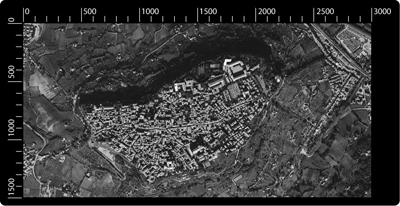You are in: Home page > Magazine Archive > An urban density benchmark
An urban density benchmark

Benno Albrecht

Orvieto
Sir Patrick Abercrombie promoted, in 1926, a campaign to contain cities and ribbon development, in the same period Clough Williams-Ellis wrote a book, England and the Octopus, criticizing sprawl. In 1958 William H. Whyte Jr. stated, in his book The Exploding Metropolis, that "sprawl is bad aesthetics, it is bad economics".
Urban sprawl criticism has been putting forward long time ago but even today we say that sprawled city should have general metamorphosis. However, is also clear that there have been no alternatives and operative strategies suitable to face and to replace the sprawling process.
One of the characteristics of urban sprawl is that the need for new areas to be developed and to be used for infrastructure does not decrease even where the population is stable or even decreasing. The size of European cities has grown from the 50’s to 78%, compared to a population increase of only 33% (Urban sprawl in Europe, The ignored challenge, EEA Report No 10/2006).
The definition of a benchmark about urban density is perhaps a necessary prelude for a city with a suitable caring capacity.
Increasing existing urban density may involve the reduction of the distance between workplace and residences of workers. By decreasing the distances it decreases consumption and the impact of the transports on the environment. A high urban density corresponds to a high intensity of use of infrastructure, the reduction of long-range of urban systems, frameworks and facilities.
The shorter distances involving scale economies and optimization of equipment and it also compacts the catchment areas of infrastructure and the possibility to supply and the provision network.
Urban density implies the control possibility of the global cycle of urban metabolism and that of networks and waste, which can be centralized, optimized and controlled. Urban densification involves the horizontal distribution, to everyone, of the added value of the land rent that is now focused on gains new constructions and exchange type of use in the expansion of urban areas.
Every process of densification must involve a measure of urban containment (urban growth boundaries, UGB). The attractiveness to the market to act in the city already built can only happen if you do not made available for construction the empty urban belt. Another important part for the success of the projects of urban densification, at least in the Italian reality, is related to the tax treatment of municipal income that we need completely to rethink.
Higher housing density specifically increases tax incomes without increasing significantly the capacity of infrastructure and pipelines. A dense settlement is more sustainable than a sprawled one, with the same results, as quality of life and quality of architecture, simply because it consumes less soil.
We must establish and agree to the "right density" of a part of the city, which is the point of sublimation of a dense urban area that can become over populated or congested.
One possibility we have is to establish a benchmark, a reference quantity, and our proposal is to take as a reference the density of the historical , pre-industrial city, the typical city of the northern Italy.
The density must be measured as square meters, sqm, of built up buildings/ sqm of land area, and not according to the data of population concentration.
The densities of the historic centre of cities in the Veneto and Trentino are swinging between 2.3 and 2.9 sqm/sqm, 2,6 sqm/sqm average. The constant data is understandable because there is a physiological limit to the increase in density resulting from the construction techniques which limited the height of buildings and their relationship with the unoccupied spaces.
In many areas of the post-war expansions you encounter rather similar density data and ranging between 0.5 sm / sm and 1 sm / sm. This means that the suburbs consume soil around 5 or 3 times more than in town centres, with an obvious lower quality spatial, architectural and even life.
Urban design which aims at saving soil, adjusting and redesigning the city post-war art is underestimated by the architectural culture in recent years, but we still need it.
Benno Albrecht is architect and Professor in architectural and urban Composition at the IUAV University of Venice. He published: Conservare il futuro. Il pensiero della sostenibilià in architettura (Padova 2012); Le origini dell’architettura (con L. Benevolo, Roma-Bari 2002).
Bibliography
Abercrombie P.(1926). The Preservation of Rural England, London: Hodder and Stoughton Ltd.
Albrecht B. (2008). Metodo della pianificazione urbanistica-Disegno urbano sostenibile. In: AA.VV., Il nuovo manuale di urbanistica, vol. 2, Roma: Ed. Mancosu, p. 4-15.
Clough W-E. (1928). England and the Octopus, London: Geoffrey Bles.
William H. Whyte Jr. (1958). The Exploding Metropolis, Garden City, N.Y.: Doubleday.
EEA - European Environment Agency (2006). Urban sprawl in Europe, The ignored challenge, EEA Report No 10/2006.

.














